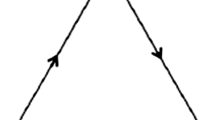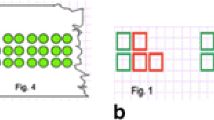Abstract
This paper investigates the notion of semiotic scaffolding in relation to mathematics by considering its influence on mathematical activities, and on the evolution of mathematics as a research field. We will do this by analyzing the role different representational forms play in mathematical cognition, and more broadly on mathematical activities. In the main part of the paper, we will present and analyze three different cases. For the first case, we investigate the semiotic scaffolding involved in pencil and paper multiplication. For the second case, we investigate how the development of new representational forms influenced the development of the theory of exponentiation. For the third case, we analyze the connection between the development of commutative diagrams and the development of both algebraic topology and category theory. Our main conclusions are that semiotic scaffolding indeed plays a role in both mathematical cognition and in the development of mathematics itself, but mathematical cognition cannot itself be reduced to the use of semiotic scaffolding.




Similar content being viewed by others
References
Agre, P. (1997). Computation and human experience. Cambridge: Cambridge University Press.
Benci, V., & Di Nasso, M. (2003). Numerosities of labelled sets: a new way of counting. Advances in Mathematics, 173(1), 50–67.
Berggren, J. L. (1986). Episodes in the mathematics of medieval Islam. New York: Springer.
Bredon, G. E. (1993). Topology and geometry. New York: Springer-Verlag.
Brooks, R. A. (1990). Elephants don’t play chess. Robotics and Autonomous Systems, 6(1), 3–15.
Brooks, R. A. (1991). Intelligence without representation. Artificial Intelligence, 47(1), 139–159.
Cajori, F. (2007). A history of mathematical notations (Vol. I). New York: Cosimo Classics.
Clark, A. (1998). Magic words: How language augments human computation. In P. Carruthers & J. Boucher (Eds.), Language and thought: Interdisciplinary themes (pp. 162–183). Cambridge: Cambridge University Press.
Cooper, G. M., & Hausman, R. E. (2007). The cell. A molecular approach (4th ed.). Washington, D.C.: ASM Press.
Eckmann, B. (1994). Mathematical Miniatures B (pp. 1–58). Online publication available at: http://www.indiana.edu/~jfdavis/notes/eckmann.pdf. Accessed 15 September 2014.
Frank, M. C., Fedorenko, E., & Gibson, E. (2008). Language as a cognitive technology: English-speakers match like Pirahã when you don’t let them count. In Cognitive science society: Proceedings of the 30th annual meeting of the cognitive science society (pp. 421–426). Red Hook: Curran Associates, Inc.
Grant, E. (1974). A source book in medieval science. Cambridge: Harvard University Press.
Hilbert, D. (1925). On the Ininite. In J. Heijenoort (Ed.), From Frege to Gödel: A source book in mathematical logic, 1879–1931 (pp. 369–392). Cambridge: Harvard University Press.
Hoffmeyer, J. (2008). Semiotic scaffolding of living systems. In M. Barbieri (Ed.), Introduction to biosemiotics. The new biological synthesis (pp. 149–166). Dordrecht: Springer Science+Business Media B.V.
Hutchins, E. (2001). Cognitive artifacts. In R. A. Wilson & F. C. Keil (Eds.), The MIT encyclopedia of the cognitive sciences (pp. 126–128). Cambridge: The MIT Press.
Hutchins, E. (2005). Material anchors for conceptual blends. Journal of Pragmatics, 37(10), 1555–1577.
Johansen, M.W. (2010). Naturalism in the Philosophy of Mathematics, Copenhagen: Faculty of Science, University of Copenhagen, 2010. (Online publication available at: http://www.nbi.dk/natphil/prs/mwj/Dissertation-mwj2010.pdf).
Johansen, M. W. (2013). What’s in a diagram? On the classification of symbols, figures and diagrams. In M. Lorenzo (Ed.), Model-based reasoning in science and technology. Theoretical and cognitive issues (pp. 89–108). Heidelberg: Springer.
Johansen, M. W., & Misfeldt, M. (2014). Når matematikere undersøger matematik- og hvilken betydning det har for undersøgende matematikundervisning. MONA, 2014(4), 42–59.
Katz, V. J. (1998). A history of mathematics: An introduction (2nd ed.). Reading: Addison Wesley Publishing Company.
Kirsh, D., & Maglio, P. (1994). On distinguishing epistemic from pragmatic action. Cognitive Science, 18(4), 513–550.
Kjeldsen, T. H., & Carter, J. (2012). The growth of mathematical knowledge—introduction of convex bodies. Studies in History and Philosophy of Science Part A, 43(2), 359–365. doi:10.1016/j.shpsa.2011.12.031.
Kline, M. (1990). Mathematical thought from ancient to modern times. New York: Oxford University Press.
Krömer, R. (2007). Tool and object. New York: Birkhuser Verlag AG.
Lakoff, G., & Johnson, M. (1999). Philosophy in the flesh: The embodied mind and its challenge to western thought. New York: Basic Books.
Lützen, J. (2010). The algebra of geometric impossibility: descartes and montucla on the impossibility of the duplication of the cube and the trisection of the angle. Centaurus, 52(1), 4–37.
Mancosu, P. (2009). Measuring the size of infinite collections of natural numbers: was Cantor’s theory of infinite number inevitable? The Review of Symbolic Logic, 2(4), 612–646.
Menninger, K. (1992). Number words and number symbols: A cultural history of numbers. New York: Courier Dover Publications.
Misfeldt, M. (2011). Computers as medium for mathematical writing. Semiotica, 2011(186), 239–258.
Norman, D. A. (1991). Cognitive artifacts. In J. M. Carroll (Ed.), Designing interaction: Psychology at the human-computer interface (pp. 17–38). Cambridge: Cambridge University Press.
Norman, D. A. (1993). Things that make us smart. Reading: Addison-Wesley Publishing Company.
Otte, M. (2006). Mathematical epistemology from a peircean semiotic point of view. Educational Studies in Mathematics, 61(1–2), 11–38.
Rashed, R. (1994). The development of Arabic mathematics: Between arithmetic and algebra. Boston studies in the philosophy of science (Vol. 156). Dordrecht/Boston: Kluwer.
Rheinberger, H.-J. (1997). Toward a history of epistemic things: synthesizing proteins in the test tube. Stanford: Stanford University Press.
Steinbring, H. (2006). What makes a sign a mathematical sign? – An epistemological perspective on mathematical interaction. Educational Studies in Mathematics, 61(1–2), 133–162.
Stjernfelt, F. (2011). On operational and optimal iconicity in Peirce’s diagrammatology. Semiotica, 2011(186), 395–419.
Zhang, J., & Norman, D. (1994). Representations in distributed cognitive tasks. Cognitive Science, 18, 87–122.
Author information
Authors and Affiliations
Corresponding author
Rights and permissions
About this article
Cite this article
Johansen, M.W., Misfeldt, M. Semiotic Scaffolding in Mathematics. Biosemiotics 8, 325–340 (2015). https://doi.org/10.1007/s12304-014-9228-6
Received:
Accepted:
Published:
Issue Date:
DOI: https://doi.org/10.1007/s12304-014-9228-6




